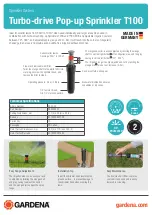
19
K000104 - BW4+
EN
The normally high degree of turbulence in the plate heat exchanger gives a
self-cleaning effect in the liquid channels, which reduces fouling and the build-up
of contamination, which can seriously reduce heat transfer capacity and increase
pressure drop.
In some applications, the fouling tendency can be very high, e.g. when using
extremely hard water at high temperatures. In such cases, it is always possible to
clean the plate heat exchanger by:
■
Circulating a cleaning liquid (CIP - Cleaning In Place).
■
A solution of 5 % phosphoric acid or 5 % oxalic acid in water is recommended to
chemically clean the channels.
■
The flow rate of the cleaning liquid should be greater than the design coolant
flow, and it should flow in the reverse direction through the heat exchanger
compared to the normal operation flow direction.
C L E A N I N G O F C O O L A N T S I D E
6.2 C L E A N I N G
After the cleaning process, it is very important that the heat exchanger is
flushed thoroughly with clean water before start-up.
Heavy condensation can have a self-cleaning effect, washing the plate heat
exchanger and reducing fouling on the gas side. In applications where the gas con-
tains elements of soot, grease or oil residues the risk of clogging the gas channel
can be high. In such cases, it is always possible to clean the plate heat exchanger
by:
■
Blocking the gas connections.
■
Circulating a cleaning liquid (CIP - Cleaning In Place) either through the con-
densate connections or (if the fouling issue has been addressed in the design
phase) through specially designed connections on the connecting pipes. A
suitable CIP-solution for the residues from the gas should be used.
AT T E N T I O N !
Chemicals known to corrode copper (i.e. ammonia, sulphur,
etc.) are strictly forbidden to use as cleaning agent.
■
The flow rate of the cleaning liquid should be greater than the design gas flow,
and it should flow in the reverse direction through the heat exchanger com-
pared to the normal operation flow direction.
C L E A N I N G O F G A S S I D E
After the cleaning process, it is very important that the heat exchanger is
flushed thoroughly with clean water before start-up.


































